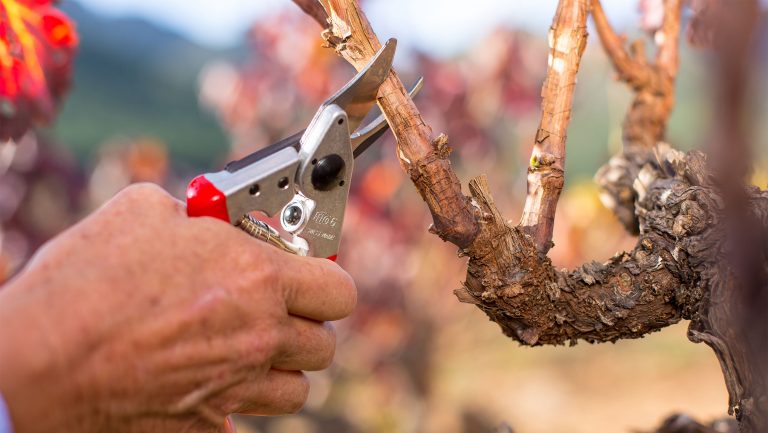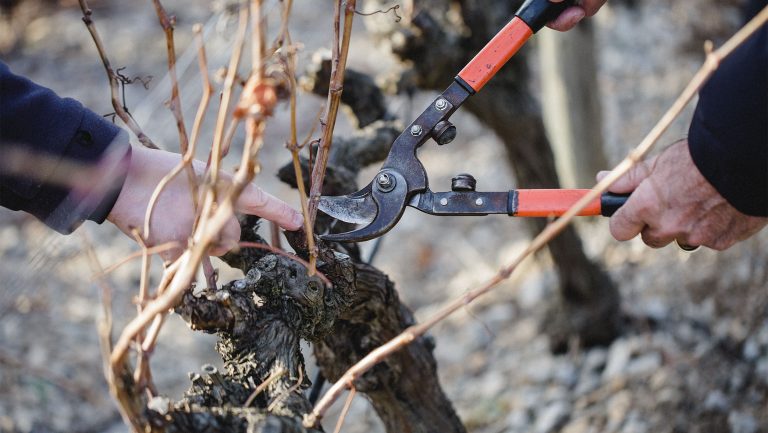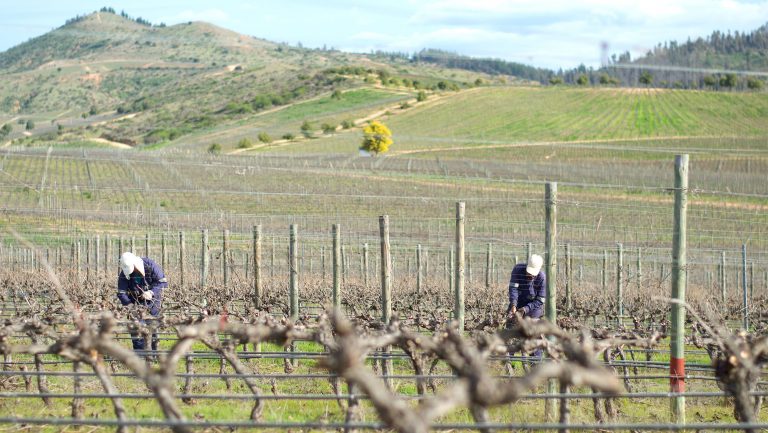Winter pruning might seem like a simple, routine part of winegrowing—the final goodbye to the previous season and the first hello to the next one. However, this grueling, repetitive task is a fundamental step in determining how many grapes will grow during the coming season—and the ones after that.
Pruning is a highly complex operation, with a number of factors to be considered: a vine’s vigor and energy, training system, desired yield, health, local climate, and soil conditions, among others. The way these elements are taken into account play a big role in how the vine will fare over several years.
On grapevines, fruit-bearing canes grow on one-year-old wood that emerged from a bud formed the previous year. Because of this multi-year cycle, bad pruning choices that limit the number of productive buds or affect sap flows can reduce yields significantly for several years. Winegrowers get very protective about the way pruning is done in their vineyards because their income and livelihood can depend on it.

Don’t miss the latest drinks industry news and insights. Sign up for our award-winning newsletters and get insider intel, resources, and trends delivered to your inbox every week.
“Done by hand in the heart of winter, pruning is certainly one of the most important steps for producing great wine,” says Guillaume Barraud, the deputy director of estates for Gérard Bertrand in southern France. “It requires a well-defined strategy and clear intentions. And it requires great concentration from vignerons so they can choose, with speed and clarity, what gesture they need to make to orient the plant’s development.” Done well, pruning gives a vine clear direction, which can also facilitate the work of pruning from year to year.
Barraud sees this yearly task as both “technical and artistic—and an act of patience, as it can go on for four months.” Alain Deloire, a professor of viticulture at L’Institut Agro in Montpellier, elaborates on this by saying that “pruning vines is an art form, but a worker who needs to prune 700 vines a day doesn’t have much time to be an artist.”
By providing the vine with structure and direction, this yearly operation is also a determining factor in the lifespan of a vine, the sustainability of vineyards, and, because of its high costs and long-term effects, the financial sustainability of grape growers and wine producers. It can also affect a plant’s capacity to resist deadly diseases and be used to help the vines better resist the effects of climate change. In short, pruning is how we harness vines to make them produce grapes that are suitable for winemaking.
Harnessing Nature
Left to its own devices, “a single vine would seek to keep growing and could reach up to 30 meters (100 feet),” explains Bourgogne vigneron Benoit Pagot. In such a context, the vine would ripen grapes “to a level that will make them attractive for birds and other animals that will help disperse the seeds, and that is often at a lower leaf area-to-fruit ratio than what it takes to ripen fruit to human standards for winemaking,” says Justine Vanden Heuvel, a professor at the School of Integrative Plant Science at Cornell University.

Using pruning to give the vine a shape (i.e. training it) and planting thousands of vines close together is a way of turning it into a productive agricultural plant. “Pruning to create trellised vines provides better light exposure and better airflow, which provides better photosynthesis and reduces risks of disease. Pruning is also how you select productive vegetal material and its renewal the following year,” says Philippe Rolet, the managing director at Viña Los Vascos in Chile. The goal is to help the plants produce more ripe grapes while keeping the vines as healthy as possible. Creating this architecture is a years-long process of cutting and shaping; nature won’t do it on its own.
Quality and Quantity
Deloire points out that pruning, in an immediate sense, is about the number of fruiting canes, and therefore, primarily about quantity. However, because the number of canes and buds left after pruning influences how the vine will invest its energy into vegetative and fruit growth, quantity is strongly related to quality. The phenolic maturity and concentration of the fruit will be affected by how much overall growth is happening.
As Vanden Heuvel explains, “The vine stores carbohydrates in the roots, trunk, and cordons that are used for growth in subsequent years. When you think about spring growth, that early flush of root growth and then shoot growth is completely fueled by stored resources in the vine.”
Consequently, the number of shoots left after pruning should be restricted to reflect the vine’s productive capacity. This doesn’t mean, however, that restricting growth and yields automatically makes for better fruit. The point is to achieve that somewhat elusive state befitting the place and winegrowing objectives: balance.
That balance, explains South African viticulturist Rosa Kruger, the founder of the country’s Old Vine Project, takes into account yield, quality, and income. “When we prune existing vineyards, every one of them is considered separately. We look at the previous years’ growth or vigor, we consider the previous season’s crop level, and only then do we try to balance the expected crop level with the income for that specific vineyard (price for the wine or price per ton). At the end of the day every block must pay for itself. Only then will it really be sustainable.”
Longevity and Viability
As Kruger advocates through the Old Vine Project, sustainability also comes from managing vines for the long term, which at a very basic level means pruning with care. “The health of the plant is always the main consideration,” says Kruger. “If the vine is healthy and strong, it will give you a good crop anyway and live much longer. Being greedy and cutting only for fruit, especially when the vine is young, is never a good philosophy, unless you are happy with lesser quality and removing the vines after 15 or 20 years.”

Vanden Heuvel also insists on good pruning as a tool for sustainability on many levels. “Growers need to take a long-term perspective on pruning and vine balance in that they need to maintain the vine form and fruiting at a viticulturally and economically sustainable level over years.”
Replanting is costly, and new vineyards only reach production after four or five years, which makes keeping vines alive and productive all the more sensible for wine producers. However, as Deloire points out, this requires well-trained workers, which can be quite a challenge as “these days, finding workers is a problem, trained or not.” Mechanical pruning or pre-pruning can be a solution to the lack of workers and it reduces costs in the short run, but it also tends to reduce the lifetime of vines considerably.
Fighting Disease
Skillful pruning is also a primary factor in keeping vines healthy. While it is quite common to cut canes as close as possible to the trunk of the vine, numerous winegrowers have come to realize, over the last couple of decades, that this creates bigger pruning wounds on the vine. With those injuries come two major consequences. First, the scar tissue builds up inside the old wood, inhibiting and weakening sap flows within the vine, and therefore compromising the vine’s productivity and longevity. Second, the pruning wounds create larger points of entry for diseases like Esca, another heavy source of vine mortality.
“The biggest change in pruning over the past decades is the use of pruning methods that reduce the spread of grapevine trunk disease,” says Vanden Heuvel. Diseases like Eutypa and Esca have been causing massive losses worldwide, reducing yields and the lifespan of vineyards. In its most virulent form, Esca can kill a vine in a matter of weeks, and numerous vineyards are losing vines at a rate that can severely compromise their viability.
Many winemakers, including everyone interviewed for this article, agree that it is crucial to leave short stumps, also known as desiccation cones, when cutting back canes or spurs to make sure the scar tissue builds up away from the sap flows. These bits of cane can then be removed the following year, after they have dried up and are no longer a potential point of entry for disease. Pagot explains that this creates a “non-mutilating pruning that keeps sap flows strong and avoids wasting the vine’s energy.”
Kruger also insists on avoiding pruning in the rain, as humidity promotes the growth of fungi and therefore increases the risk of trunk disease. She adds that the number and size of pruning wounds “can also be reduced by good and careful shoot thinning the previous spring that leaves less canes to cut back.”

Pruning and Climate Change
By promoting vine longevity, good pruning practices can also help vineyards fight the growing challenge of climate change. Older vines are sturdier and less affected by weather variations. In particular, they are more drought resistant thanks to a deeper root system that can draw water and nutrients from deeper in the soil.
Winegrowers can also use various techniques to help vines adjust to more unpredictable conditions. Pruning later in the season, which delays budbreak and reduces the risk of damage from spring frosts, is a more and more frequent approach. However, Barraud also points out that later pruning is not a universal solution. “We’ve used it in vineyards that are particularly susceptible to frost, but like any practice in the vineyard, nuances and thought must be put in,” he says. Effects on vigor and the particulars of grape variety and site have to be factored in.
Deloire, who is currently doing research on this strategy, says that care must be exerted in just how late the work is done. With very late pruning (especially after budbreak), the plant may have spent energy that will be lost with the canes, affecting productivity and ripening.
On another front, Kruger notes that bush vines or the old method of échalas (tying every vine to a single stake) can be useful as they create smaller vines that need less water and provide better shade for ripening fruit under harsh sunlight.
With expectations of longer episodes of drier and hotter conditions for so many regions, shifts in training and pruning systems may indeed become important ways to allow winegrowing to continue in changing circumstances. As seasons become more and more unpredictable, the winter work of pruning and the choices it involves aren’t about to get any easier.

Dispatch
Sign up for our award-winning newsletter
Don’t miss the latest drinks industry news and insights—delivered to your inbox every week.
Rémy Charest is a journalist, writer, and translator based in Quebec City, Canada. He has been writing about wine and food since 1997 for various Canadian and American print and online publications, including Chacun son vin/WineAlign, Wine Enthusiast, Le Devoir, Le Soleil, EnRoute, Palate Press, Punch Drink, and Châtelaine, and has been a regular radio columnist for CBC/Radio-Canada. He has also judged national and international wine competitions, notably the WineAlign National Wine Awards of Canada, the TEXSOM International Wine Awards, and the International Rosé Championships.






